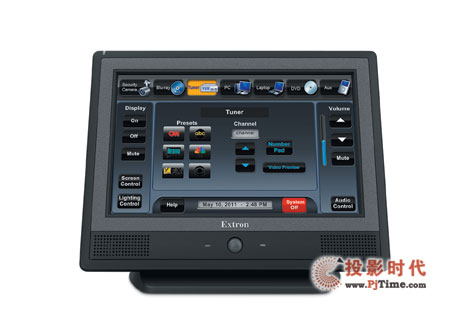 Extron Electronics has introduced two newly designed 7" touch screens. The TLP 710MV and TLP 710TV are fully configurable 7" TouchLink touchscreens. Its modern, narrow-frame design is suitable for the aesthetic needs of any installation environment. The Extron TLP 710 Series supports 800x480 resolution touch screens and Power over Ethernet (PoE) without the need for a local power supply. Each model has a built-in twisted pair receiver that accepts S-video or composite video over standard CAT 5 cable. This enhanced connection provides integration flexibility and helps in cable management by minimizing the number of touchscreen connections. The TLP 710MV can be mounted on a wall, lectern, or other surface while the TLP 710TV is designed to be mounted on a tabletop or mounted on a VESA stand. Both products are ideal for a control environment requiring a 7" control panel and an elegant touch screen design.
Extron Electronics has introduced two newly designed 7" touch screens. The TLP 710MV and TLP 710TV are fully configurable 7" TouchLink touchscreens. Its modern, narrow-frame design is suitable for the aesthetic needs of any installation environment. The Extron TLP 710 Series supports 800x480 resolution touch screens and Power over Ethernet (PoE) without the need for a local power supply. Each model has a built-in twisted pair receiver that accepts S-video or composite video over standard CAT 5 cable. This enhanced connection provides integration flexibility and helps in cable management by minimizing the number of touchscreen connections. The TLP 710MV can be mounted on a wall, lectern, or other surface while the TLP 710TV is designed to be mounted on a tabletop or mounted on a VESA stand. Both products are ideal for a control environment requiring a 7" control panel and an elegant touch screen design. “Our customers requested a touchscreen that integrates the smooth shape and touch of our 10†TLP 1000 Series, but with a smaller size,†said Casey Hall, vice president of sales and marketing at Extron, “The TLP 710 series with its slimmer form factor The same powerful features, including PoE and built-in twisted pair receivers, can meet this need. â€
The GUI Configurator software makes it easy to configure the touch screen without the need for additional graphics programs. This software provides ready-to-use templates for single display rooms, dual display rooms, split rooms, multiple image systems, and video conferencing venues. These designs can be used directly in some applications or custom-made by simply changing individual graphical elements.
The TLP 710MV and TLP 710TV can work with any Extron IP Link control processor, such as the Extron IPCP 505. They are designed for applications that require full interactive control of video systems for display systems, display devices, switchers, and source devices. The touch screen and IP Link control processor communicate over a standard Ethernet network, leveraging existing network infrastructure.
Die casting is the pressure of metal molds on a die casting machine and is the most productive casting process. Die-casting machines are divided into two categories: hot-chamber die-casting machines and cold-chamber die-casting machines. The hot chamber die casting machine has a high degree of automation, less material loss, and higher production efficiency than the cold chamber die casting machine. The aluminum alloy die castings that are widely used today can only be produced on cold chamber die casting machines due to their high melting point. The main feature of die casting is that the molten metal fills the cavity under high pressure and high speed, and is formed and solidified under high pressure. The air in the cavity is wrapped inside the casting to form subcutaneous pores, so aluminum alloy die castings should not be heat treated, and zinc alloy die castings should not be sprayed on the surface (but can be painted). Otherwise, the internal pores of the casting will expand due to thermal expansion and cause the casting to deform or bubble when the above-mentioned treatment is performed. In addition, the mechanical cutting allowance of die castings should also be smaller, generally around 0.5mm, which can not only reduce the weight of castings, reduce the amount of cutting to reduce costs, but also avoid penetrating the surface dense layer and exposing subcutaneous pores, causing The workpiece is scrapped.
Resin sand molding,Resin Coated Sand Mold Casting,Furan resin sand casting,Green sand casting
Tianhui Machine Co.,Ltd , https://www.thcastings.com